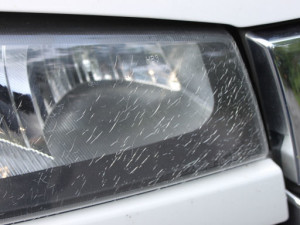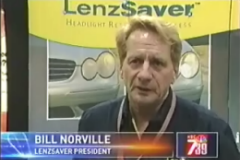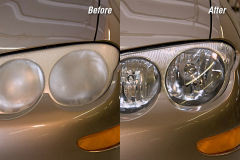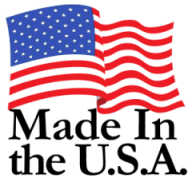History
For 25 years, the LenzSaver™ process thrived in the aircraft industry as a reliable method for removing scratches from airplane windows.
Automotive headlight lenses are made of a similar plastic, a stretched and formed acrylic. When the lens was manufactured, it was coated with a UV protectant and then baked and slow cooled. As the plastic was heated, the coating embedded in the substrate levels of the plastic. The protectant degrades over time and the lens becomes more susceptible to the damaging effects of pollution and the environment.
To protect the polycarbonate, manufacturers coat the headlight during manufacture. It is this coating that deteriorates and causes the cloudiness and yellowing.
Nearly all damage to cloudy headlights is on the outside and is limited to the factory protective coating. Any interior damage such as moisture or with cracks or chips should not be restored, they should be replaced.
The patented LenzSaver™ process restores the lens and applies a UV Protectant. At the end of the service when the hair dryer heats the lens, the plastic expands, drawing the UV Protectant deeper into the substrate levels for ultimate lens protection.
It’s science.
The LenzSaver™ polishes are blended in a vacuum-emulsifying machine. Under nitrogen, the particles bond in such a way that they create a homogenous product. The product is sustained in this environment and stored in a foil packet until the packet is opened exposing the mixture to oxygen for the first time. The oxygen activates the polish and then it’s ready to use.
Covered by at least 3 patents.
5,407,615; 5,337,524; 5,334,335 and other patents pending.
Frequently Asked Questions
What is crazing? 
Crazing is a series of fine cracks on the surface of a material. Crazing can weaken the material and the slightest amount of tension, such as a rock hitting the surface, will cause noticeable fractures.
Less luminosity is difficult to detect
Yellowed lenses may only be shining at an unsafe 50 percent efficiency or less. Reaction times of the driver are affected by how much and how clearly they can see hazards around them. Yet this drop in luminosity happens gradually as the headlight ages, so car owners may not even notice the change.
Clear. But for how long?
The LenzSaver™ UV Protectant will last at least as long as the original finish, but it depends on the lenses’ exposure to pollution and the environment. One to three years on average but it does depend on exposure to pollutions and sunshine.
What if my headlights have been treated with clear coat?
Clearcoating headlight lenses is bad practice, it sometimes gets done by dealers looking for a quick fix. All traces of the clear coat have to be removed before applying Lenzsaver. The kit comes with sanding discs for this purpose and for removing heavier abrasions or damage to the lens. These discs are better than sand paper as the abrasives in them are consistent and even. Also see the instructions in the kit.
Can LenzSaver used to restore motorcycle fairings?
Yes but we found that sometimes the plastics used on aftermarket fairings are not as good as the original. The kit works well on OEM fairing plastics.



